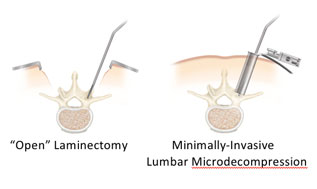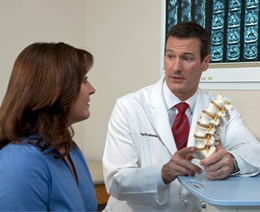Minimally-Invasive Lumbar Microdecompression
Minimally-Invasive Lumbar Microdecompression

Minimally-Invasive Lumbar Microdecompression (MILM) is a surgical procedure used to treat spinal stenosis and herniated discs. During the procedure bone spurs, thickened ligament tissue, and herniated disc material that are causing pressure on the spinal nerves are removed through a 18mm tube (the diameter of a dime) that is inserted through small incision. MILM is an alternative to a traditional “open” laminectomy.
The benefits of minimally invasive spine surgery include:
- Small incisions and minimal scar tissue formation
- Less damage to surrounding muscle and soft tissues
- Decreased blood loss
- Decreased pain and reduced need for pain medication
- Quicker recovery and faster return to regular activities
- Shorter hospital stays
- Many procedures can be performed as outpatient surgery
- Decreased risk of postoperative infection
If You Have Decided To Have Surgery:

- Call Dr. Jeffords’ staff to schedule your surgery date and the date for your pre-operative consultation.
- At your pre-operative consultation Dr. Jeffords and his staff will discuss the procedure with you, answer any questions you may have, and have you sign a consent form for surgery.
- You will be given prescriptions for pain medicine and instructions for post-operative care.
- Your pre-operative evaluation at Saint Joseph’s Hospital or Resurgens Surgery Center (depending on where your surgery will be) will be scheduled on the same day as your pre-operative consultation. You may have a chest X-ray, EKG, and blood-work performed.
- If you take aspirin or anti-inflammatory medications daily, STOP these medications at least 7 days before your surgery.
- If you are a smoker you should make every effort to stop smoking as soon as you can before surgery (at least 2 weeks prior to surgery). You should not smoke for at least 6 weeks after surgery.
- You will check into the hospital or the surgery center the morning of surgery.
Surgical Procedure:
- Your anesthesiologist will bring you to the operating room and put you to sleep for the operation.
- There are usually two nurses in the room and a surgical assistant that assists Dr. Jeffords with the operation.
- A small incision (usually about one inch or less) is made in the lower back and a series of tubes is inserted through the incision to dilate the muscle tissue and provide exposure to the spine. The final tube measures 16-18 mm in diameter (about the size of a dime or nickel).
- Dr. Jeffords then uses special instruments to work through the tube to remove bone, ligament and disc material to open the spinal canal and relieve the nerve compression.
- The incision is closed with resorbable stitches that are placed beneath the skin.
- The surgery will take approximately 1 hour.
After Surgery:
- You will be taken to the recovery room (PACU) and stay there for about 1-1 ½ hours. Afterwards you will be discharged, or if you are being admitted, taken to your room where you can visit with your family.
- Dr. Jeffords will speak to your family while you are in the recovery room.
- The nurses will get you out of bed shortly after surgery and a physical therapist may work with you to ensure that you are strong enough to go home.
- Most patients are often able to go home the day of surgery. Some patients go home the morning after surgery.
- You will be able to ride in a car or plane upon leaving the surgery center or hospital.
After Going Home:
- A small waterproof dressing is placed over the incision in the operating room. You may shower over the dressing beginning the day after surgery. The dressing should be removed 7 days after surgery.
- You will be given pain medication and a muscle relaxant to help control post-operative pain and spasms. Make sure you do not drive or operate heavy machinery while on the medication.
- There will be some activity restrictions that you will need to follow. For the first six weeks, avoid excessive bending or twisting at the waist, and no heavy lifting.
- You may drive once you are no longer taking narcotic medications (generally at about 3-5 days).
- You can expect to return to sedentary office or desk work approximately 3-5 days after surgery as long as you can maintain the activity restrictions.
- Physical therapy for back strengthening and flexibility will begin 2 weeks after surgery.
- Sports activities such as golf or tennis may be resumed at 6 weeks.
